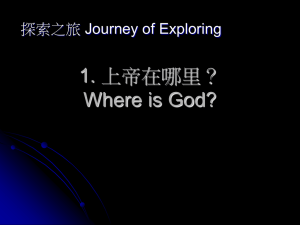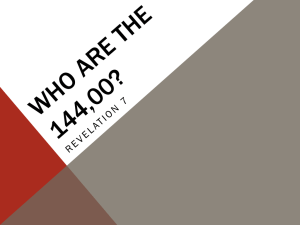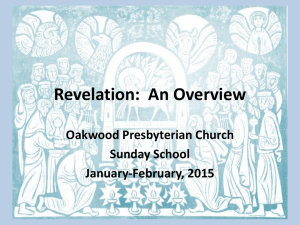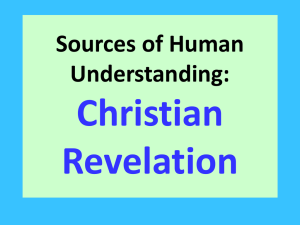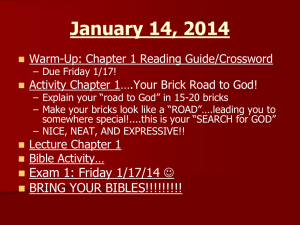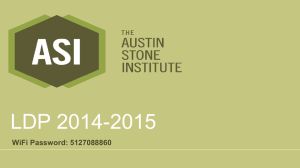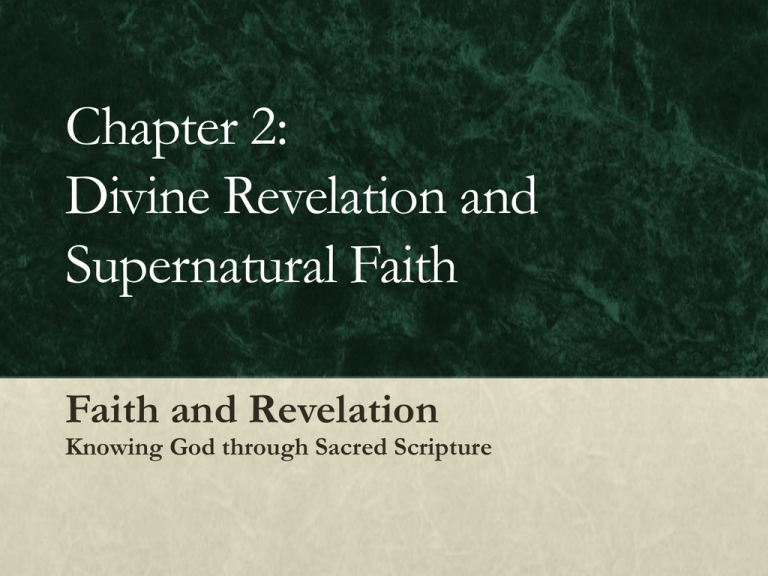
Chapter 2:
Divine Revelation and
Supernatural Faith
Faith and Revelation
Knowing God through Sacred Scripture
BASIC QUESTIONS
• What is supernatural Revelation?
• Why does God reveal himself to us?
• How does God make it possible to know him?
KEY IDEAS
• In supernatural Revelation God “unveils” truths about himself
and our salvation that exceed our natural intellectual capacity.
• God draws human beings to himself because of his loving
magnanimity.
• We can know God because he elevates our natural intellects
through grace so we can grasp the supernatural truths he
reveals through deeds and words.
ANTICIPATORY SET
Opening prayer reading:
• The raising of Lazarus (Jn 11:1–44)
Discussion:
• How do the actions of Jesus Christ and the words he speaks relate to one
another?
FOCUS QUESTIONS
What is the difference between natural revelation and Divine Revelation?
Natural revelation is how God makes himself known to people through
creation, and Divine Revelation is how God reveals himself to people directly
through chosen individuals.
What is the literal meaning of the word “revelation”?
It means to uncover, or unveil, something hidden.
What does the word “revelation” mean in theological terms?
Revelation means God’s manifestation of truth to his people.
What kinds of truths has God revealed?
God has revealed truths about himself and creation, in particular, the origin
and destiny of human beings and of the world.
FOCUS QUESTIONS
What is the intelligibility of revealed truths to the human intellect?
Some are accessible to the human mind on its own, whereas others exceed all
created intellect.
What does it mean to say that Christ is both the one who reveals and who is revealed?
He is the one who makes the definitive Revelation of God, and what is
revealed primarily is Christ himself.
What is the double meaning of the “Word of God”?
Sacred Scripture and Jesus Christ.
Why is “Ignorance of the Scriptures ignorance of Christ”?
St. Jerome meant that, because Christ is the subject of all the Scriptures, we
cannot know Christ apart from them.
TRUTHS REVEALED BY God
FOCUS QUESTIONS
What are the two kinds of revealed truths?
Natural truths, which are accessible to natural reason, and supernatural truths, or
mysteries, which are beyond the reach of human reason.
What are some examples of supernatural truths, or mysteries?
The existence of three divine Persons in one God, the union of the divine and human
natures in the divine Person of Jesus Christ, and the Real Presence of Christ in the Holy
Eucharist.
What does it mean to say that Revelation is received mediately?
It is revealed to a person directly, who then transmits it to other persons. Most people
receive Divine Revelation mediately.
Who are some of the persons who have mediated Divine Revelation?
Abraham, Moses, the prophets, and definitively, Jesus Christ.
GOD DRAWS HIS PEOPLE TO HIMSELF
FOCUS QUESTIONS
Why does God reveal himself ?
He wants to draw people to himself.
In what ways does God want us to exceed our human capacities?
He wants us to become capable of knowing him, responding to him, and
loving him beyond what our own human capacities would otherwise allow.
According to the document Dei Verbum from Vatican II, what is the relationship between
words and deeds in the economy of Revelation?
“The works performed by God in the history of salvation show forth and bear
out the doctrine and realities signified by the words; the words, for their part,
proclaim the works, and bring to light the mystery they contain.”
GUIDED EXERCISE
Think/Pair/Write/Share on the following question:
• How does the passage from the document Dei Verbum, no. 2
(“It pleased God…”), reveal God’s magnanimity?
God wanted men to “have access to the Father” and to
“become sharers in the divine nature.” He wanted to be a
friend to man. This is generous on God’s part. It is like
the richest man in the world adopting poor people and
sharing everything he has with them.
GUIDED EXERCISE
In the Gospel of St. John, Christ said, “I am the Resurrection and the Life”
(Jn 11:25), just before he raised Lazarus from the dead. Here is an example of a
work paired with a deed.
Work with a partner to look up this event and then explain how the “word”
that God spoke was connected to the “deed” that he subsequently worked, and
then explain the connection between the word and the deed, how they mutually
explain each other.
Jesus said to Martha, the sister of Lazarus, who had died,
the words, “I am the Resurrection and the Life.” Then he
performed the deed of raising Lazarus from the dead. The
words are mysterious and the deed is beyond human
power. However, when Jesus raises Lazarus we understand
that the words mean he can raise people from the dead.
The words make us realize why Jesus could raise Lazarus:
because he is the source of life.
HOW SUPERNATURAL TRUTHS
CAN BE KNOWN
FOCUS QUESTIONS
What does it mean to say that the created intellect has a basic and radical capacity to be
elevated beyond its natural powers?
It means that our intellects, with the help of grace, can understand supernatural
truths. The more grace, the better our understanding of supernatural truth can
be.
What is the normal subject of the natural drive and capacity of our intellects?
To understand the essence of physical, or material, things in the world.
What is the “appropriate,” or exact, object for which the human intellect is searching?
Truth in its entirety.
GUIDED EXERCISE
Free write for five minutes on the following questions:
•Do you find in yourself an innate desire to know the truth?
•How does it show itself in your life?
• Briefly share responses.
FOCUS QUESTIONS
How are we able to know supernatural truths?
God elevates our intellects to see things we ordinarily could not.
How is God’s Revelation transmitted to us?
Mediately, through the Church.
What keeps the message of Revelation from being confused or corrupted?
When establishing his Church, Christ guaranteed the assistance of the
Holy Spirit to ensure the faithful transmission of Divine Revelation.
The Holy Spirit guides the Church and her teaching authority, or
Magisterium, in confirming the teachings of Christ and applying those
teachings to modern-day situations.
CLOSURE
•Write a paragraph summarizing how and why God reveals
supernatural knowledge about himself to us.
Homework Assignment
Reading
• THE TRUTHFULNESS OF DIVINE REVELATION
through “Miracles,” including the sidebar, MOTIVES OF
CREDIBILITY.
Study Questions
• Questions: 1–5.
• Practical Exercises 1–3.
Workbook
• Questions 1–15.
Alternative Assessment
Have a class discussion on Practical Exercise 2 (p. 53)
•Why might God select certain individuals, such as Moses, to transmit his
Divine Revelation rather than reveal himself directly to everyone?
In transmitting Revelation, God wants to work with
intermediaries rather than directly with each person even
though he does want to have a personal relationship with
each soul.
BASIC QUESTIONS
• How do we know if a revelation is actually from God?
• What are the main “motives of credibility”?
• What is a miracle?
KEY IDEAS
• Because the content of revealed truth is not self-evident, God
provides external evidence for believing the revealed truths
outside the truths themselves. These evidences are termed
“motives of credibility.”
• The main signs, or motives of credibility, are the miracles of
Christ and his saints; the fulfillment of prophecies; the sublimity
or dignity of the message itself; and the growth, holiness,
fruitfulness, and stability of the Church.
• A miracle is an extraordinary and observable fact or action
performed by God that defies the laws of nature.
Anticipatory Set
•Opening prayer reading: Mark 2:1–12
• What reason does Christ give for healing the paralytic?
Christ performs an act people can witness—the healing
of a man who is paralyzed—to “prove” he can perform
an act which cannot be seen—the forgiveness of sin.
THE TRUTHFULNESS OF
DIVINE REVELATION
Focus Questions
Why must a Revelation from God be true?
God can neither deceive nor be deceived.
Why does reason dictate that we need some evidence to confirm that the source of a
Revelation is God?
We should only believe something to the extent that the truth of a
particular statement can be reasoned or that the mediate source of the
statement is known to be reliable. Extension: We may be able to
reason why the method of long division works or we may simply take it
on faith because we know the teacher is trustworthy.
Guided Exercise
Think/Pair/Share on the following question:
•How does the folktale “The Boy Who Cried Wolf ” illustrate the principle that
belief in what an intermediary testifies depends on his trustworthiness?
When the boy cried wolf the third time, nobody
believed him—even though he was telling the truth—
because he had proven himself untrustworthy by his
prior falsehoods.
Focus Questions
Why do we need external evidence that a Revelation comes from God?
The content of a revealed truth is not self-evident; therefore it needs
evidence outside itself.
What are the four main signs, or “motives of credibility,” that God provides to
assure us that his Revelation is trustworthy?
(1) The miracles of Christ and his saints; (2) the fulfillment of
prophecies; (3) the sublimity or dignity of the Gospel message; and
(4) the growth, holiness, fruitfulness, and stability of the Church.
Guided Exercise
Perform a paragraph shrink on the selection from Vatican I
beginning, “For the submission of our faith.”
God provides divine acts to show everyone that what he
reveals can be trusted.
Sidebar: MOTIVES OF CREDIBILITY
Guided Exercise
•Based on the sidebar “Motives of Credibility,” complete the
following table (see the next slide) to understand better the internal
and external motives for credibility.
Guided Exercise (continued)
Motives of Credibility according to the Nature and Source of the Evidence
Kind of
Example
Explanation
Evidence
External
Internal to
the
Revealed
Truth Itself
Inherent in
Mankind
Motives of Credibility according to the Nature and Source of the Evidence
Kind of
Example
Explanation
Evidence
External
A fulfilled prophecy. If something is predicted in writing and it
comes true, we have reason to believe other
things the writing says.
Internal to
the
Revealed
Truth Itself
The life of the
Church.
Inherent in
Mankind
A profound peace.
The Church is part of Revelation. The fact that
the Church has endured for 2000 years and
always reformed itself testifies there is
something extraordinary and therefore
trustworthy about it.
If something gives you a positive value you
didn’t possess before contact with that thing, it
tells you there is something extraordinary
there worth listening to.
a. Miracles
Focus Questions
What is the original meaning of the word “miracle”?
Something admirable or astonishing.
What does the term “miracle” mean in theological terms?
“An extraordinary and observable fact or action that defies the laws of nature.”
Why do we ascribe miracles to God?
By definition they do not have any possible natural cause; miracles can only
have God himself as their immediate cause.
What do miracles display?
God’s omnipotence and external proofs of God’s Revelation.
a. Miracles
Focus Questions
Why would miracles be impossible if God did not exist?
Only God can set aside his own laws of nature. Extension: When human
beings do extraordinary things with technology—for example, fly or talk to
someone on the other side of the world—they do not set aside the laws of
nature but work within them.
Why does God’s existence explain the possibility of miracles?
Because God can do everything that can be done.
What can even God not do?
He cannot do anything that is metaphysically impossible or morally evil.
a. Miracles
Focus Questions
Is the Church credulous when it comes to miracles?
No. She regards miraculous claims with a healthy dose of skepticism and scrutinizes
them carefully.
What is a favorable outcome of the Church’s examination of a miracle or apparition?
It is that (1) there is no viable natural explanation for the phenomenon and that (2) the
“message” of the revelation, if any, is not incompatible with what the Church teaches.
Why does God work miracles today?
God uses them to call our attention to something important for our salvation.
What is the greatest miracle in all of history?
The Resurrection of Jesus Christ.
Closure
•Write a paragraph defining miracles and explaining why it is not
unreasonable to believe in their possibility.
Homework Assignment
Reading
• Sidebar: “TEST ALL THINGS.”
Study Questions
• Questions: 6–10.
• Practical Exercise 4.
Workbook
• Questions 16–18.
Alternative Assessment
Complete a free write response to Practical Exercise 4:
Make a list of beliefs you acquired about God and faith and the
approximate age at which you acquired them.
Who was the most influential person in teaching you these matters of faith
when you were small?
What influences have you had since that period of time?
BASIC QUESTIONS
• When have miracles occurred?
• How does the Church determine whether a miracle has, in fact,
taken place?
• What are the three most common categories of miracles?
KEY IDEAS
• God worked miracles during the times of the Old Testament, the
times of the New Testament, and in subsequent history, all the
way until today.
• The Church requires a lengthy, scientifically, and theologically
strict process to determine if a miracle has taken place.
• Three of the most common categories of miracles are
apparitions of the Blessed Virgin Mary or another saint, miracles
of the Eucharist, and miracles of healing.
Anticipatory Set
Imagine the case of a physician who contracted an incurable form
of skin cancer from repeated exposure to X-rays over many years.
The physician prays to a specific person who has died and soon has
a complete cure.
•How could one could be certain such a “cure” could really be called
a miracle?
Focus Questions
What are some examples of miracles in the Old Testament?
The ten plagues on Egypt, the parting of the Red Sea, the manna
sent from Heaven, the destruction of Jericho, and the survival of
the prophet Daniel in the lion’s den.
What are some examples of miracles performed by Christ?
He turned water into wine, fed multitudes, walked on water, calmed
a storm, healed people of a variety of health conditions, exorcized
demons, and raised the dead.
Focus Questions
What was the difference between the miracles the Apostles performed after the Ascension and the
ones Christ performed while on earth?
The Apostles’ miracles were done in Christ’s name to show that they acted under
his authority, while Christ performed his miracles by his own authority.
What was the first miracle the Apostles were involved with?
The miracle of “speaking in tongues,” whereby the Apostles’ preaching was heard
and understood in many different languages after the descent of the Holy Spirit.
What are three “major categories” of miracles which have occurred over the past two thousand
years?
Apparitions of the Blessed Virgin Mary or another saint, miracles of the
Eucharist, and miracles of healing.
Marian Apparitions
Focus Questions
Who now normally begins the investigation of a claim of a Marian apparition?
The local bishop, although the national conference of bishops or the Vatican
itself may intervene.
What aspects of an alleged apparition are investigated?
The investigation considers the probability of a supernatural occurrence, the
personal qualities of the person receiving the alleged vision, the content of the
message (if any), and the fruits of the revelation (conversions, increased prayer,
charitable acts, etc.).
What are some factors that might force a negative judgment?
Errors in fact or doctrine, evidence of personal financial profit, immoral acts,
or psychological disorders of the visionary.
Focus Questions
What are the three findings of an investigation into a claim of an apparition
and what does each mean?
“Judged as supernatural” means the apparition seems to be
authentic; “judged as not supernatural” means that the apparition is
not authentic, and “not judged supernatural” is a neutral
statement.
How long can investigations take?
Decades or even centuries.
If an event is “judged as supernatural,” what can happen?
The bishop or conference may permit public devotion.
Focus Questions
How many claims of Marian apparitions were there in the twentieth century?
There were 386.
How were these cases disposed?
Of them, seventy-nine were dismissed as “judged as not supernatural”,
and nearly all of the rest have received a neutral verdict.
How many apparitions in all of Church history has the Church fully approved?
Ten.
What are the locations of the three most popular Marian apparitions?
Lourdes, Fatima, and Guadalupe.
Our Lady of Lourdes
Focus Questions
What is the significance of the name the lady gave to St. Bernadette?
St. Bernadette was told to ask the name of the lady who was appearing to her,
who answered, “I am the Immaculate Conception,” a dogma about the Blessed
Virgin Mary that the Church had just solemnly defined a few years earlier, of
which St. Bernadette probably had no knowledge.
What kind of miracle is associated with Lourdes?
Miracles of healings.
How many miracles have been certified at Lourdes?
Sixty-seven people have been declared to have been miraculously healed of
desperate illnesses and disabilities under the strictest of medical scrutiny, and
thousands more have claimed physical and spiritual healings resulting from
their visits there.
Our Lady of Fatima
Focus Questions
To which three persons did the Blessed Virgin Mary appear at Fatima?
The three children, Bl. Jacinta, Bl. Francisco, and St. Lucia (ages
seven, nine, and ten, respectively).
What did Our Lady ask the children to do?
She asked them to say the rosary, to offer themselves to God, and to
bear suffering as an act of reparation for the conversion of sinners.
What public miracle occurred at Fatima?
The lady told the children she is “the Lady of the Rosary,” and a
crowd of many thousands saw the sun “dance” in the sky.
Our Lady of Guadalupe
Focus Questions
Where and when did the miracle of Guadalupe occur?
Outside Mexico City in 1531.
To whom did the Blessed Virgin Mary appear?
To a native Mexican, St. Juan Diego.
What sign did the Blessed Virgin Mary use to show Bishop Zumarraga that it
really was her?
Her image was miraculously imprinted on St. Juan Diego’s tilma.
Our Lady of Guadalupe
Focus Questions, continued
What is miraculous about the image of Our Lady of Guadalupe?
Modern scientific tests have failed to identify how the image was
made or why it has not faded or deteriorated over the past 600 years.
Who is the patroness of the Americas?
Our Lady of Guadalupe.
Guided Exercise
Work with a partner to do search the Internet to learn more about
one of the fully approved but lesser known Marian apparitions:
•Laus, France (1664–1718);
•Paris (1830);
•La Sallette, France (1846);
•Pontmain, France (1871);
•Beauraing, Belgium (1932–1933);
•Banneux, Belgium (1933); and
•Akita, Japan (1973).
Share results.
Eucharistic miracles
Bolsena-Orvieto, Italy
Focus Questions
What is the Real Presence?
It is the Catholic doctrine that Jesus Christ is really and truly present—Body, Blood,
Soul and Divinity—in the Eucharistic species.
What Eucharistic miracle occurred in Bolsena-Orvieto, Italy?
A German priest named Peter had trouble believing in the Real Presence. When he
stopped to say Mass on his way to Rome, the consecrated host began to bleed.
Where are the host and bloodstained corporal today?
In the Orvieto cathedral.
What did Pope Urban IV do when he learned of this event?
He instituted the feast of Corpus Christi, the “Body of Christ.”
Lanciano, Italy
Guided Exercise
Work with a partner to write and answer three Focus Questions
based on the section “Lanciano, Italy.”
Share results with the class.
Miracles of healing
Focus Questions
Why is there such a difference between the number of unexplained healings credited
to prayer and the number of proven miraculous interventions?
The criteria for establishing miracles of healing are very strict and the
unexpected healings must be rigorously studied.
What are the criteria for a cure to be declared miraculous?
There must be an accurate diagnosis of a permanent illness or infirmity
by competent medical authority, and the prognosis must be grim. The
cure itself must be immediate, complete (no need for rehabilitation or
convalescence), and permanent, and the medical treatment prescribed
must not be a contributing factor in the healing.
Focus Questions
How is an alleged healing at Lourdes investigated?
The claimant party presents its case to the Lourdes Medical Bureau.
If it passes their scrutiny, the case is presented to the Lourdes
Medical Committee, which is populated by nearly two dozen
physicians from around the world. Their investigation usually takes
five to ten years; if they rule an alleged healing as “medically
inexplicable,” then the case is sent to the bishop of the diocese
where the cured person lives. The bishop will consult local experts
and the Vatican before deciding whether to formally recognize that
a miracle has taken place.
In the case of a person whose cause for canonization is underway, who makes
the final determination of whether a miracle has taken place?
After a thorough and many-leveled investigation, the Pope makes
the final decision. Extension: In order for someone to be
canonized, or named a saint, the person must perform a number of
proven miracles from Heaven.
Guided Exercise
A Think/Pair/Write/Share on the following question:
Why is it prudent for the Church to have such strict guidelines to determine
whether a healing is miraculous or not?
•
•
•
•
Some cases could be fraudulent.
Some cures could be of natural origin.
People could accuse Catholics of credulity or gullibility.
The Church would rather have a miracle be unrecognized
than make a mistake by making a false declaration.
Closure
Read Supplemental Reading 2, “Norms on apparitions,” and then
write a paragraph arguing that it is reasonable to accept the Church’s
judgment that some Marian apparitions are worthy of belief.
Homework Assignment
Reading
• Complete THE TRUTHFULNESS OF DIVINE
REVELATION (Prophesies through Personal Dispositions),
including the sidebar STEPS OF DIVINE REVELATION.
Study Questions
• Question 20.
• Practical Exercise 5.
Workbook
• Questions 19–21.
Alternative Assessment
Return to the example of the physician with skin cancer from the
Anticipatory Set.
Read about the case from the Vatican’s Web site:
http://www.vatican.va/latest/documents/escriva_miracolocanoniz_en.html.
In light of this and the information presented in this lesson, discuss
again the question, “How can one be confident that miracles can
really occur?”
BASIC QUESTIONS
• How are prophesy, the experience of Christians, and the Church
motives of credibility for Divine Revelation?
• What is the role of freedom in accepting Revelation as true?
KEY IDEAS
• Prophecy is a motive of credibility because prophets talk to
human beings in the name of God, and their fulfilled prophesies
are signs of the truthfulness of their message. The Christian’s
experience of Christ offers an internal proof of the truth of
Revelation because Christ satisfies the highest human aspirations.
The propagation, sanctity, fruitfulness, unity, and stability of the
Church provide a motive of credibility for her divine mission.
• Nevertheless, despite this body of external evidence, each person
still has the freedom to accept or reject the truthfulness of
Revelation.
Anticipatory Set
Consider the following institutions:
•The Jewish Sanhedrin
•The Roman Empire
•Arianism
•The French Revolution
•The U.S.S.R.
•Nazi Germany
What do these all have in common?
• They tried to destroy the Church.
• They no longer exist.
b. Prophecies
Focus Questions
To what does “navi” (or “nabi”), the Hebrew word for “prophet,” refer?
“He who talks to man in the name of God.”
How does this definition relate to Christ as the Prophet?
He spoke to man in the name of God.
Who are some of the prophets of the Old Testament?
Jeremiah, Isaiah, Daniel, Micah, Hosea, and Nehemiah.
Focus Questions
What is a prophecy?
“An infallible prediction of a contingent future event, which can be
foreseen with certainty only through supernatural illumination.”
Who, then, is the ultimate author of every prophecy?
God.
How is Isaiah’s prophecy about the Virgin Birth a sign that offers verification of its
own truthfulness?
When Isaiah’s prophecy (“Behold a virgin shall conceive, and bear a son”
[7:14]) was fulfilled in Christ, it gave credibility to this prophesy and to
everything else Isaiah said. It also lent credibility to Jesus as the promised
Messiah.
c. Christ Satisfies the Highest Human Aspirations
Guided Exercise
Perform a focused reading of the section “Christ Satisfies the
Highest Human Aspirations” based on the following question:
How does the experience of living the Christian Faith provide an internal
proof that the Faith is true?
The Revelation of Christ promises and actually delivers
to the believer self-fulfillment; serenity; goodness;
freedom; and a spotless, peaceful, and fruitful life. In
other words, Christ satisfies every desire of the human
heart.
d. The Life of the Church
Guided Exercise
Work with a partner to read the section “The Life of the Church,” and then
make a bullet-point summary of points in favor of the assertion that the
Church herself is a miracle on earth.
•The Church has survived and thrived for the past 2000 years, despite
on-going, serious opposition from the world and internal difficulties.
•The Church has never changed her teachings in all these years, but
has continued to wage war against a huge array of negative societal
influences.
•The Church has continued to produce eminent examples of
holiness, the saints.
•Without failing to respect legitimate diversity and freedom, the
Church has maintained her internal unity.
•The Church has done great good to society in every age.
e. The Personal Dispositions Needed to Accept Divine Revelation
Focus Questions
Do miracles, prophecies, and other motives of credibility give us absolute certainty that
the truths taught to us by the Church come from God?
No; we have to be open to receiving the truth.
What factors make it difficult to accept Divine Revelation despite good evidence?
Original Sin and its consequences can lead us to reject Divine Revelation.
What helps us accept Divine Revelation?
Love for the truth and the desire to find God incline us to accept
Revelation.
Sidebar: STEPS OF DIVINE REVELATION
Guided Exercise
Islam asserts that Jesus was a prophet but that Mohammed (early seventh century)
is the final and greatest prophet of God (Allah).
Based on the sidebar “Steps of Divine Revelation,” discuss why Catholicism cannot
accept the Prophet Mohammed’s testimony in the Koran.
The climax of Revelation is found in Christ: in his Person, deeds, and
words. What preceded Christ was preparation for this ultimate
Revelation, and his is the definitive Revelation that will never pass away;
no new public revelation is to be expected “before the glorious
manifestation of our Lord, Jesus Christ.” Therefore, God did not send
another prophet after he sent his Only Son.
Closure
Write a paragraph summarizing how miracles, prophecies, the
experience of Christians, and the existence of the Church herself
are proofs that Divine Revelation can be trusted.
Homework Assignment
Reading
• DIVINE REVELATION LEADS TO FAITH.
• THE MOTIVE AND OBJECT OF THE ACT OF FAITH.
• CONCLUSION.
Study Questions
• Questions: 11, 13–14, 17–18.
• Practical Exercise 6.
Workbook
• Questions 22–24.
Alternative Assessment
Free write on Practical Exercise 6 in light of this lesson:
Counterfeit Heavens
•What do many people today actively seek that they hope will bring happiness?
• People seek intrinsically good things like friendships, music, sports,
entertainment, and love relationships to bring happiness. They also
seek abusive things like extra- and premarital sex, drug and alcohol
abuse, driving recklessly, divorce, and violence as roads to happiness.
•Why is it that so many people still find themselves unhappy and unfulfilled even after they attain
these goals?
• On the one hand, sinful choices for happiness will eventually leave a
person empty. On the other hand, even when one chooses objectively
good earthly things, they can leave a person unsatisfied because only
God can fulfill what the human heart desires.
BASIC QUESTIONS
• What are the qualities of faith?
• What are the motive and objects of faith?
KEY IDEAS
• Faith is a certain and free supernatural assent of the intellect
through which a truth revealed by God is believed on the
authority of God who reveals it.
• The motive for faith is the authority of God who reveals. The
objects of faith are God himself, all other supernatural truths
God wished to reveal, and those natural truths God wished to
confirm.
Anticipatory Set
Opening prayer reading: Mark 9:14–29.
Christ had just returned from the mountain of the Transfiguration with
Sts. Peter, James, and John and saw a big crowd and an argument going on
between the scribes and his disciples.
Discuss what the episode seems to be saying about faith.
The people Christ encountered were faithless. He may have been
saying the boy’s own father could cure his son if he had faith; the
father has some faith but needed more. Christ seemed to be saying
that prayer can increase faith.
DIVINE REVELATION LEADS TO FAITH
Focus Questions
Is faith a feeling?
No, it is an assent, or agreement, of the intellect.
Is Divine Revelation self-evident to our intellect?
No.
What is the role of the will in the act of faith?
Even though our senses and our intellect tell us something is true, we still
must choose to believe.
What is faith?
It is a certain and free supernatural assent of the intellect through which a
truth revealed by God is believed on the authority of God, who reveals it.
Guided Exercise
Based on the sidebar, “Motives of Credibility,” complete the following
graphic organizer to better understand the internal and external
motives for credibility.
Quality
Supernatural
Free
Certain
Qualities of Faith
Explanation
Quality
Supernatural
Free
Certain
Qualities of Faith
Explanation
To believe a revealed truth requires grace, which is a supernatural
gift, and many of the truths to believed, such as the Trinity, are
supernatural in nature.
Because a truth of faith is not self‐evident, it can only be accepted
by an act of free will.
Revelation is accepted on the authority of God who can neither
deceive nor be deceived. The will, inspired by the Holy Spirit,
orders the intellect to give its full assent.
THE MOTIVE AND OBJECT OF
THE ACT OF FAITH
Focus Questions
What does it mean to say, “We do not ‘just believe’; rather, we believe in something”?
Faith has a content: we do not simply believe that God exists, but we
believe in God himself and in his Revelation, that is, his attributes and his
relationship with us and with his creation.
What is the motive, or reason, for making an act of faith?
The motive for making an act of faith is the authority of God.
What are the three objects of faith?
God; truths which can only be known through Revelation; and natural
truths, which God wishes to confirm and strengthen our knowledge.
Guided Exercise
Think/Pair/Write/Share:
What is an example of each of the three objects of faith?
The Blessed Trinity is an example of God as the object of
faith. The Seven Sacraments are an example of
supernatural truths we could never know on our own. The
immortality of the soul is a natural truth that God wished
to make certain we would firmly believe.
Closure
Write a paragraph summarizing the qualities, motive, and objects of
faith.
Homework Assignment
Study Questions
• Questions: 12, 15–16, 19.
Workbook
• Questions 25–32.
Alternative Assessment
Complete the following table to solidify your understanding of the four
“motives of credibility” by listing them and providing an example of
each.
Motive
Miracles
Prophecies
Sublimity of
the message
The life of the
Church
The Four “Motives of Credibility”
Example
Motive
Miracles
The Four “Motives of Credibility”
Example
Jesus rose from the dead so we can believe what he taught.
Prophecies
The Suffering Servant in Isaiah 53 is an exact portrait of Christ’s
Passion but it was written hundreds of years before Isaiah’s words
came true. We can believe everything Isaiah said.
Sublimity of
the message
Forgive your enemies ‘feels true’ and it is deeply satisfying when
practiced, but it is not something human beings would think of on
their own. For this reason, I am reasonable in believing this
teaching comes from God.
The imminent death of the Catholic Church has been announced
many times but it continues to endure. Therefore, I can trust what
it teaches.
The life of the
Church


